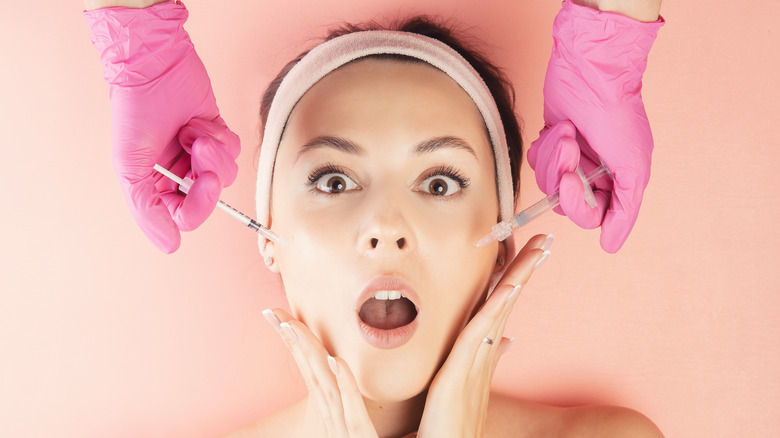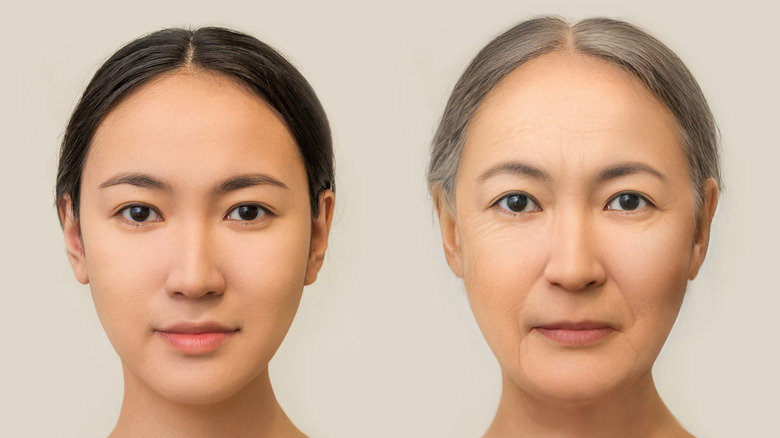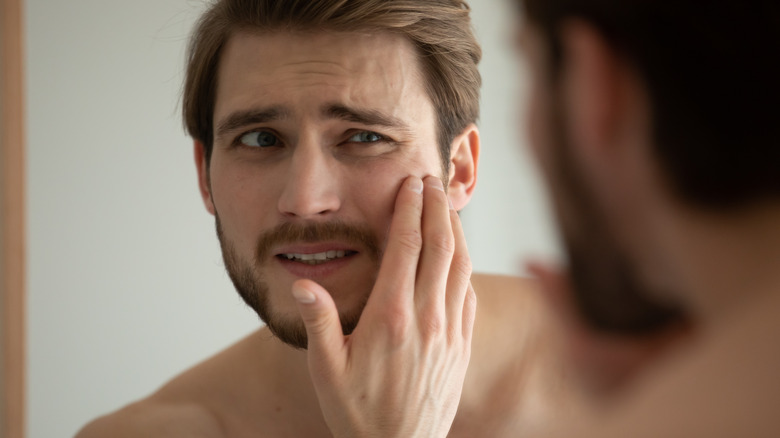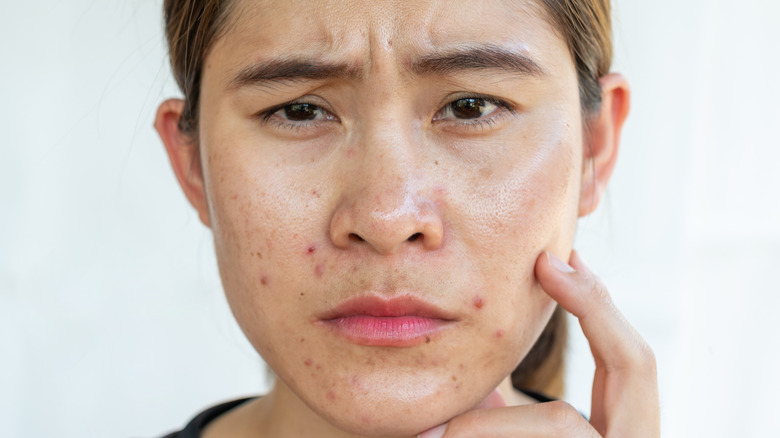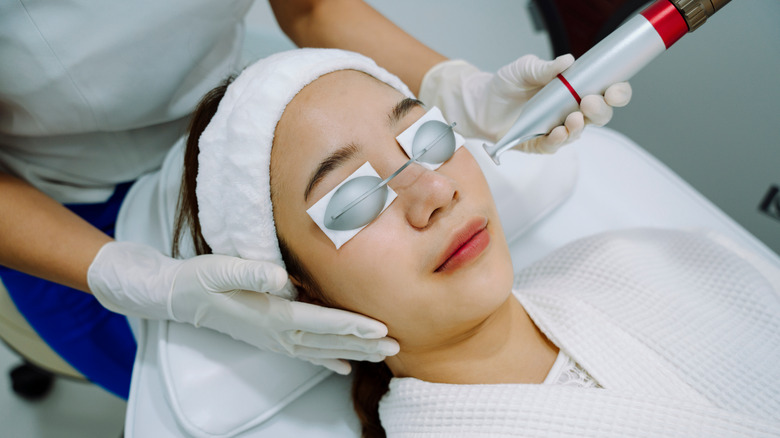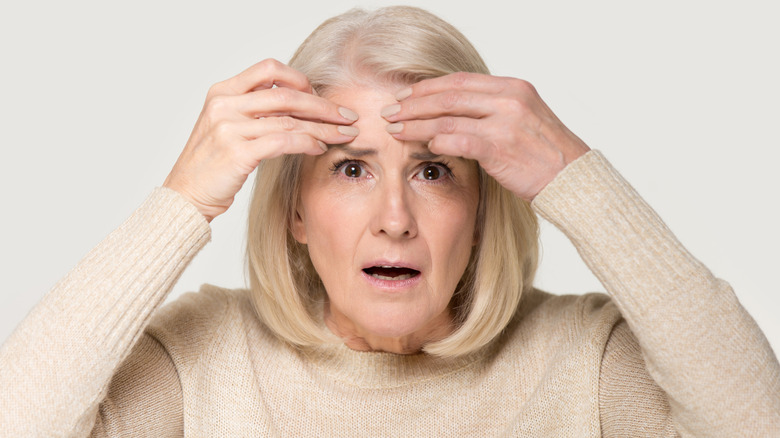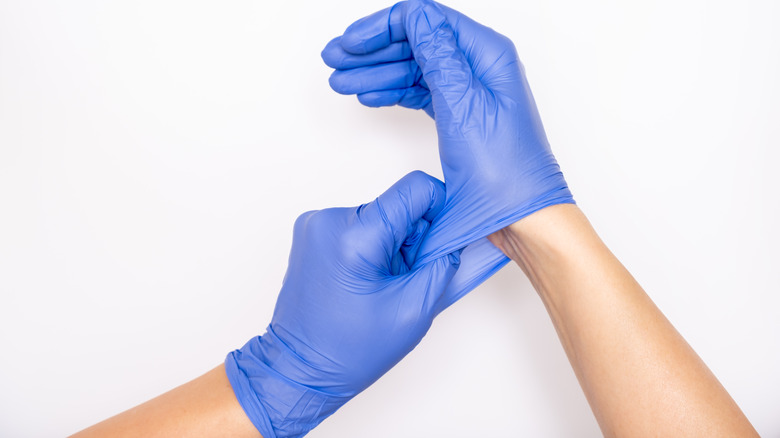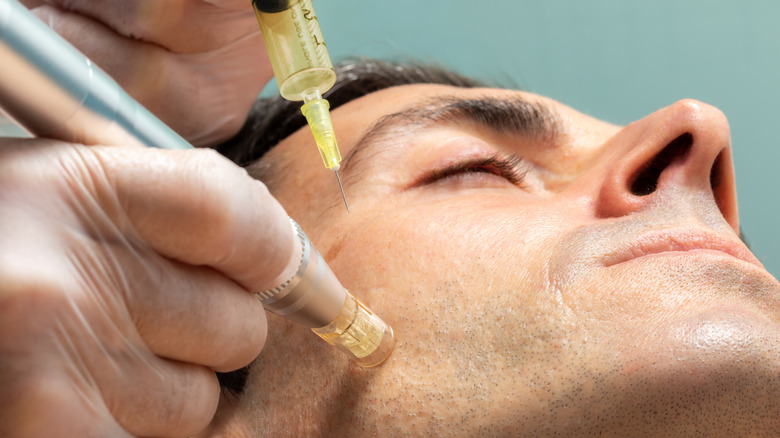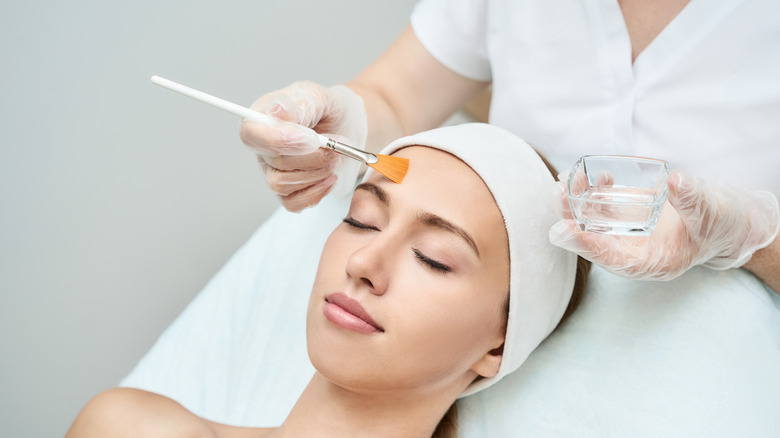Everything You Should Know Before Getting A Vampire Facial
A vampire facial sounds gruesome, but the actual procedure is nothing spooky at all. Its less eyebrow-raising name is PRP facial or microneedling with PRP (platelet-rich plasma). And yes, it does involve blood — your own — but just a few tablespoons of it. Okay, maybe it does seem a tiny bit creepy.
Platelet-rich plasma therapy has actually been used for decades in orthopedics and sports medicine to accelerate healing in muscles, joints, and tendons, as well as in dermatology for stimulating hair growth, according to Johns Hopkins Medicine. The patient's blood is placed in a centrifuge to separate out the plasma and platelets, producing the "liquid gold" or platelet-rich plasma, then injected into the skin to fast-track the recovery period.
In aesthetics, the vampire facial uses a microneedling device (such as a micropen or a dermaroller) which has short, fine needles to "injure" the skin and induce collagen production. The PRP is injected or spread topically over the face to stimulate new cell growth and bring about a more glowy, smoother, and youthful appearance (via Healthline).
"[PRP] triggers collagen production by stimulating the body's natural wound-healing response," says Cleveland Clinic dermatologist Dr. Shilpi Khetarpal. "Collagen is the latticework of the face, so a PRP microneedling treatment helps improve skin texture and tone."
What's the importance of collagen?
So you have crow's feet at the outer edges of your eyes, "11s" on your forehead, and a bit of jowl on your jawline and chin? It's a natural process that affects us all. The culprit is collagen, which diminishes with the passage of time.
Having less collagen makes skin thinner, less elastic, drier, duller, and eventually wrinkled, according to Scientific American. "Starting in our mid-20s, we slowly begin to lose collagen," says Los Angeles board-certified dermatologist Dr. Ohara Aivaz. "For women, we can lose up to 30% of our collagen production in the first five years of menopause" (via Cedars-Sinai).
Collagen is an abundant protein that's found in our bones, cartilage, and skin. It helps keep our skin looking youthful, smooth, and plump (per Everyday Health), and "makes up 75% of skin's support structure." So finding ways to boost collagen production as we age is an important part of many anti-aging skin treatments, including the vampire facial.
What type of skin problems does the vampire facial target?
The vampire facial isn't a substitute for a surgical facelift, which will provide dramatic, long-lasting results for sagging or deeply lined skin. But for more superficial issues like fine lines, hyperpigmentation, acne scars, or changes in the skin's surface texture or pore size, a PRP treatment with microneedling can be effective for turning back the clock and achieving a healthier glow.
A review of 24 studies published in the Archives of Dermatological Research concluded that satisfaction was high after patients received PRP treatment. Reported outcomes were modest improvement in "facial skin appearance, texture, and lines." It was noted the results are not permanent though, and it's not known exactly how long they may last. Typically, multiple treatments are also needed.
"Almost anyone with some degree of sun damage or other skin aging is an excellent candidate [for vampire facials]. That can mean starting in your 20s and going up," Dr. Cameron Chesnut, a dermatologic surgeon in Spokane, Washington, told Realself.
Can it really make you look younger?
By encouraging the production of more collagen, the vampire facial has been shown to restore skin to a plumper and younger appearance. And the way this is achieved is essentially by fooling the body.
"When we inject the platelets (from the blood) into the face, it tricks the body into thinking that there has been an injury and hence, bring growth factors to aid new collagen formation," says Dr. Munir Somji, clinical director at DrMediSpa in London (via The Independent). "I use it for facials and also after surgery to speed up healing."
The effects of the PRP facial aren't immediate, though. Unlike a surgical facelift with results you can quickly see, a vampire facial takes longer to view the desired result, usually after multiple treatments. "Collagen stimulation, that tightening and remodeling of your collagen, happens over the course of six months to a year after a procedure like this," board-certified dermatologist Dr. Jordan Carqueville, founder and medical director of The Derm Institute of Chicago, told Cosmopolitan.
Is the vampire facial good for your skin?
Getting the blood's healing properties into the skin to generate cell turnover and a collagen boost is the aim of the vampire facial, resulting in skin that's smoother, more radiant, and firmer. "The plasma's the growth factor of blood — so basically that's like the fertilizer for the lawn," explains Genevieve Vielbig, a registered nurse and licensed aesthetician in New York (via Well+Good). "It's the best part of your blood. So you're microneedling your face and making all of these micro-channels by digging holes into the skin, that way the PRP can penetrate into the skin and help to heal."
The experts say there's little downside for a healthy person to get a vampire facial, except that sometimes it may not produce the desired results. "Practitioners often publicize using platelet-rich plasma immediately after microneedling, in a treatment trademarked the vampire facial," says dermatologic surgeon Dr. Suneel Chilukuri to the Dermatology Times. "We have not seen any benefit from applying PRP topically post microneedling."
Who can perform the procedure?
Since the procedure involves drawing blood and then injecting parts of it back into the skin, experts recommend that you go to a licensed, medically trained professional — preferably a board-certified dermatologist or plastic surgeon — to ensure that proper safety protocol is followed (via County of Los Angeles Public Health). Sterile technique is vitally important to prevent the spread of infectious diseases.
According to the American Academy of Dermatology, prior to seeking any medical aesthetic treatment, you should check a doctor's credentials and board certification status. You also want to know how experienced that provider is in the specific treatment you're seeking. Each state's guidelines differ regarding who is allowed to perform medical and cosmetic procedures.
"Any persons desiring cosmetic services involving needle injections should verify the services are being provided by a licensed medical provider," advises the New Mexico Department of Health. "If needles aren't handled appropriately, you could potentially increase the risk of a blood-borne infection," Dr. Michael Landen, epidemiologist at NMDOH, told KOAT-TV in Albuquerque.
It may improve acne scars
For improvement of acne scars, vampire facials have shown effectiveness in getting good results. "I love microneedling for acne scars," New York-based dermatologist Dr. Lilly-Rose Paraskevas told Men's Journal. "With every treatment, the scars are shallower and less noticeable. Even the redness within the scars can be improved. Unlike some laser treatments, there's no risk of burns or discoloration from microneedling."
And it's not just hearsay. In a 2016 study, a group of participants with acne scars received microneedling, but with only half of the face injected with PRP (the other half was treated with distilled water). Overwhelmingly, the patients gave two thumbs up for the better results on the PRP side, noting that the scars were less visible and the skin's texture was improved as well.
"[PRP with microneedling] is one of the most popular treatments at my practice," says Dr. Gary Goldenberg, assistant clinical professor of dermatology at the Icahn School of Medicine at Mount Sinai Hospital (via Women's Health). "We use it to treat acne, acne scarring, melasma, surgical scars, and fine wrinkles and lines."
How much downtime is needed after treatment?
Compared to other types of facial treatments like chemical peels, fillers, and some lasers, the vampire facial has a pretty quick recovery period. And since it's your own blood being used, "no reaction to foreign body materials" should occur (via Parade). But you can expect to have redness and even some bruising on treated areas. You'll look like you have a sunburn for several days.
"The skin will be red, blotchy, slightly swollen, possibly mildly bruised, dry and flaky. Each day these side effects improve, and usually by day four the skin is fully healed and glowing," says Dr. Julie Russak, a New York-based dermatologist, to NewBeauty. "It is recommended to avoid applying cosmetics to the treatment area for 24 hours, and we advise patients to leave the PRP on the treatment area overnight."
Keep in mind the vampire facial is not a "one and done" procedure. There's an initial series of treatments to get the ball rolling, and then perhaps once a year maintenance to keep your glowing results, per Cosmopolitan. So it can get pricey!
Combination treatments
With the success of the vampire facial in boosting collagen and elastin, many physicians have jumped on this therapy and routinely combine it with other aesthetic services (including lasers, dermal fillers, and fat grafting) for quicker tissue healing and shortened recovery periods. "The CO2 laser alone works great at introducing controlled tissue injury to stimulate wound healing. The addition of PRP to this injured site, either topically or injected, significantly enhances the end result," says Dr. Vincent McGinniss, a board-certified cosmetic and reconstructive facial plastic surgeon in Ohio (via The Aesthetic Guide).
A study on autologous fat grafting combined with PRP concluded that the grouping of the two treatments have promising results, as it's "biocompatible, inexpensive, readily available, [and] non-migratory with long-term results."
Other popular combos with PRP are erbium light therapy for pigmentation issues and fine lines, and radio-frequency microneedling for rosacea, stretch marks, and sagging skin. "PRP therapy is minimally invasive, and when paired with other procedures can produce faster, longer-lasting results," declares Levy Dermatology in Memphis, Tennessee.
What can't a vampire facial fix?
As effective as the vampire facial can be, it's still not going to fix every problem. Sometimes, nothing will take the place of a surgical procedure, fillers, a wrinkle-relaxing neuromodulator like Botox, or lasers.
Vampire facials have a reputation for doing wonders for smoothing out superficial fine lines and addressing areas of hyperpigmentation, according to Seiler Skin in Birmingham, Alabama. The healing properties of platelet-rich plasma from your blood combined with the microneedling effect has been shown to be a worthwhile investment if you're looking to turn back the effects of time for a bit.
But this anti-aging treatment, which is typically administered as a series, is not going to make a dramatic difference if you have more advanced skin laxity or deeper facial lines. "If you expect the same results as a facelift, that won't happen with this treatment," Cleveland Clinic dermatologist Dr. Shilpi Khetarpal says. "When you have a nonsurgical procedure, you are going to get nonsurgical results."
How safe is a vampire facial?
The American Academy of Dermatology warns that if you have certain conditions (such as hepatitis C, HIV or AIDS, or blood cancer) or if you're taking blood thinners for a heart condition, then the vampire facial is not for you, because those medical conditions negatively affect your platelets and you won't have success with the treatment.
If you don't have those conditions and are interested in PRP treatments, make sure you go to a licensed medical professional in an office that follows all safety protocols. Just because a facility calls itself a "med spa" doesn't mean you shouldn't do your own research to verify it. In 2020, the Las-Vegas Review Journal reported that a Nevada facility was shut down by the state for conducting medical aesthetic treatments such as vampire facials and surgeries like liposuction and penile enhancements performed by people purporting to be licensed and certified, but weren't. No medical license nor supervision by a doctor, not even anyone certified in any procedure — truly a nightmare scenario for their patients.
"When performed using proper technique and precautions, [the vampire facial] is a safe procedure," says Dr. Joshua Zeichner, a New York City board-certified dermatologist and director of cosmetic and clinical research in dermatology at Mount Sinai Medical Center (per Women's Health). "Whenever you are performing a procedure in which there is exposure to blood, sterile technique must be used to prevent infections and avoid spreading of infectious diseases."
Does a vampire facial hurt?
While Kim Kardashian said her vampire facial in 2012 was "rough and painful" and the "most painful thing ever" (per Marie Claire), the realty TV personality and businesswoman also revealed she had not used any numbing cream on her face nor any other type of painkillers — a standard pre-treatment regimen — because she had just discovered she was pregnant before the procedure.
Depending on who you ask, the vampire facial will be virtually painless or rather uncomfortable even with the numbing cream that's applied to the skin. Thinner skin areas such as the forehead and jawline, or delicate regions around the mouth and eyes, can be the most ouchy. Overall, though, numbing cream does its job pretty well for this relatively quick procedure, according to firsthand accounts in Cosmopolitan and Well+Good.
Final results won't come right away — it takes weeks to months and typically three or more treatments, says the American Academy of Dermatology.
Don't confuse it with a vampire facelift
When you're looking for more immediate gratification, a vampire facelift goes a step beyond the facial. It's still nonsurgical, but it combines a filler with the PRP. Both the facial and the facelift use a patient's own blood and includes microneedling, but the addition of hyaluronic acid filler will provide an immediate plump to the skin and an instant firmer, smoother appearance (per Healthline). "Essentially, the dermal filler will deliver the volume, and the growth factors build collagen over time to support that new volume," says Hessler Plastic Surgery in Palo Alto, California.
So instead of waiting weeks or months for the platelet-rich plasma to do its job, you can admire your brighter, tighter skin in just a few days. "The hyaluronic acid 'lifts' collapsed areas, which helps restore a more youthful and natural structure to the face. But it's the addition of PRP that starts the magic," Connecticut-based Dr. Ellen Mahony, a board-certified plastic surgeon, told Realself.
Are the results long-lasting?
Since the vampire facial increases collagen production and accelerates the turnover of skin cells, the effects from the procedure have been shown to last longer than many other nonsurgical aesthetic treatments. "The results are more noticeable after six months and can last up to 18 months," says the Center for Surgical Dermatology in Ohio.
It's not going to be anywhere near as enduring or dramatic as a surgical facelift, which can last up to 10 years, according to University of Utah Health. However, for a nonsurgical procedure, the vampire facial is a worthy option for many patients if they're just looking for a refreshed look.
"Collagen stimulation, that tightening and remodeling of your collagen, happens over the course of six months to a year after a procedure like this," board-certified dermatologist Dr. Jordan Carqueville told Cosmopolitan. He added that "generally, the cumulative results will be more noticeable with the more treatments you get."
Other alternative treatments
So maybe the thought of needles digging micro-channels into your face or having your blood drawn and re-injected into you isn't your cup of tea. Okay, then what other types of treatments can you get that will have similar results?
For the squeamish, many really good anti-aging options are at the ready that don't involve your blood. "Chemical peels, laser treatments, and microdermabrasion are other common treatments that are an alternative to PRP," according to Vanguard Aesthetic Plastic Surgery in Fort Lauderdale, Florida.
To target hyperpigmentation, peels, lasers and dermabrasion will improve texture by removing dead skin cells through a series of treatments, typically with minimal downtime. "Chemical peels can combine different brightening agents that lighten brown spots and age spots," says Dr. Binh Ngo, a dermatologist in Los Angeles at Keck Medicine of USC.
If it's plumping and more volume you want, then dermal fillers will do the job, while neuromodulators such as Botox will get rid of your scowling forehead lines and crow's feet. "There used to be few options for turning back the clock without going under the knife," reports WebMD, "But today, you can soften the effects of time on your face with many nonsurgical cosmetic procedures."

